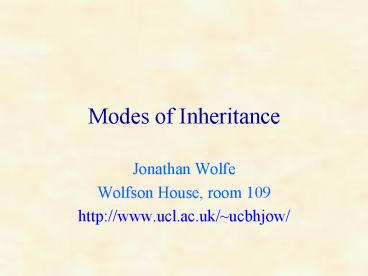Modes of Inheritance - PowerPoint PPT Presentation
1 / 17
Title:
Modes of Inheritance
Description:
Objectives - at the end of this lecture you should be able to: ... Phocomelia. Incomplete ascertainment. mitochondrial inheritance. Mitochondrial inheritance ... – PowerPoint PPT presentation
Number of Views:688
Avg rating:3.0/5.0
Title: Modes of Inheritance
1
Modes of Inheritance
- Jonathan Wolfe
- Wolfson House, room 109
- http//www.ucl.ac.uk/ucbhjow/
2
Objectives - at the end of this lecture you
should be able to
- Identify dominant and recessive Mendelian modes
of inheritance - Describe reasons why some genetic diseases seem
to depart from Mendelian expectations
3
Mendels laws
- 0. Genes are particulate and come in different
forms known as alleles. - Organisms (peas or humans!) have two copies of
each gene but transmit only one to each
offspring. Which one is transmitted is chosen at
random. i.e. if you are heterozygous for two
different alleles, the alleles will segregate
from each other in your offspring. - Where alleles of more than one gene are
segregating, segregation at each gene occurs
independently of the others.
4
Autosomal dominant inheritance
- All affected individuals should have an affected
parent - Both sexes should be equally affected
- Roughly 50 of the offspring of an affected
individual should also be affected - Huntingtons disease, Achondroplastic dysplasia,
Neurofibromatosis.
5
A large autosomal dominant pedigree!
6
Autosomal Recessive Inheritance
- Usually there is no previous family history
- The most likely place to find a second affected
child is a sibling of the first
7
Autosomal recessive
- Inbreeding increases the chance of observing an
autosomal recessive condition - E.g. Cystic fibrosis, sickle cell disease, Tay
Sachs disease.
8
Exceptions to clear cut Mendelian inheritance
- Lethal alleles
9
Exceptions to clear cut Mendelian inheritance
- Lethal alleles
- Incomplete dominance
Familial Hypercholesterolemia / normal /-
death as young adult -/- death in childhood
10
Exceptions to clear cut Mendelian inheritance
- Lethal alleles
- Incomplete dominance
- Codominance
- Silent alleles
11
Exceptions to clear cut Mendelian inheritance
- Lethal alleles
- Incomplete dominance
- Codominance
- Silent alleles
- Epistasis
The Bombay Phenotype The ABO blood group
genotype cannot be deduced in h/h homozygotes.
12
Exceptions to clear cut Mendelian inheritance
- Lethal alleles
- Incomplete dominance
- Codominance
- Silent alleles
- Epistasis
- Pleiotropy
- genetic heterogeneity
13
Exceptions to clear cut Mendelian inheritance
- Lethal alleles
- Incomplete dominance
- Codominance
- Silent alleles
- Epistasis
- Pleiotropy
- genetic heterogeneity
- variable expressivity
- incomplete penetrance
14
Exceptions to clear cut Mendelian inheritance
- Lethal alleles
- Incomplete dominance
- Codominance
- Silent alleles
- Epistasis
- Pleiotropy
- genetic heterogeneity
- variable expressivity
- incomplete penetrance
- Anticipation
E.g. Myotonic dystrophy
15
Exceptions to clear cut Mendelian inheritance
- Lethal alleles
- Incomplete dominance
- Codominance
- Silent alleles
- Epistasis
- Pleiotropy
- genetic heterogeneity
- variable expressivity
- incomplete penetrance
- Anticipation
- germline mosaicism
- phenocopies
Phocomelia
- Incomplete ascertainment
- mitochondrial inheritance
16
Mitochondrial inheritance
17
Exceptions to clear cut Mendelian inheritance
- Lethal alleles
- Incomplete dominance
- Codominance
- Silent alleles
- Epistasis
- Pleiotropy
- genetic heterogeneity
- variable expressivity
- incomplete penetrance
- Anticipation
- germline mosaicism
- phenocopies
- Incomplete ascertainment
- mitochondrial inheritance
- uniparental disomy
- linkage































